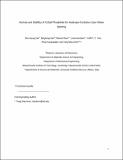Activity and stability of cobalt phosphides for hydrogen evolution upon water splitting
Author(s)
Ha, Don-Hyung; Han, Binghong; Risch, Marcel; Giordano, Livia; Yao, Koffi Pierre Claver; Karayaylali, Pinar; Shao-Horn, Yang; ... Show more Show less
DownloadShao-Horn_Activity and Stability with SI.pdf (2.723Mb)
PUBLISHER_CC
Publisher with Creative Commons License
Creative Commons Attribution
Terms of use
Metadata
Show full item recordAbstract
Late transition metal phosphides have been reported to have high activity for catalyzing hydrogen evolution reaction (HER), yet their active site and stability are not well-understood. Here we report systematic activity and stability study of CoP for HER by combining electrochemical measurements for CoP nanoparticles (NPs) with ex situ and in situ synchrotron X-ray absorption (XAS) spectroscopy at phosphorus and cobalt K edges, as well as density functional theory (DFT) calculations. Colloidally synthesized CoP NPs showed high HER activity in both acid and base electrolytes, comparable to previous work, where no significant pH dependence was observed. Transmission electron microscopy-energy dispersive spectroscopy study of CoP NPs before and after exposure to potentials in the range from 0 to 1.4 V vs. the reversible hydrogen electrode (RHE) revealed that the P/Co ratio reduced with increasing potential in the potentiostatic measurements prior to HER measurements. The reduced P/Co ratio was accompanied with the emergence of (oxy)phosphate(s) as revealed by XAS, and reduced specific HER activity, suggesting the important role of P in catalyzing HER. This hypothesis was further supported by DFT calculations of HER on the most stable (011) surface of CoP and voltage dependent intensities of both phosphide and phosphate components from P-K edge X-ray spectroscopy. This work highlights the need of stabilizing metal phosphides and optimizing their surface P sites in order to realize the practical use of metal phosphides to catalyze HER in electrochemical and photoelectrochemical devices. Keywords: Metal phosphide; Hydrogen evolution reaction; HER; Catalysis; Water splitting; Electrocatalysis
Date issued
2016-04Department
Massachusetts Institute of Technology. Department of Materials Science and Engineering; Massachusetts Institute of Technology. Department of Mechanical Engineering; Massachusetts Institute of Technology. Research Laboratory of ElectronicsJournal
Nano Energy
Publisher
Elsevier
Citation
Ha, Don-Hyung et al. “Activity and Stability of Cobalt Phosphides for Hydrogen Evolution Upon Water Splitting.” Nano Energy 29 (November 2016): 37–45 © 2016 Elsevier Ltd
Version: Author's final manuscript
ISSN
2211-2855